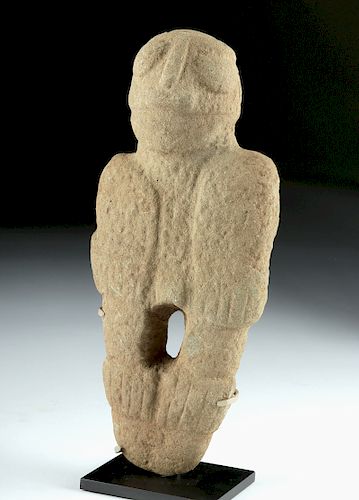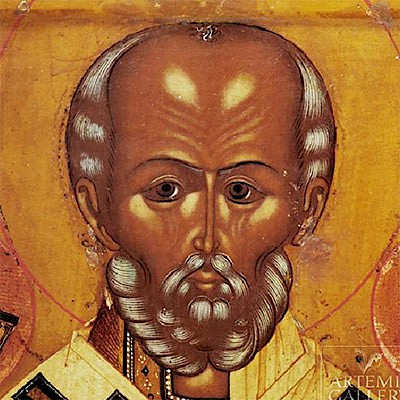Costa Rican Standing Stone Peg Figure in Diquis Style
Lot 189
About Seller
Artemis Gallery
686 S Taylor Ave, Ste 106
Louisville, CO 80027
United States
Selling antiquities, ancient and ethnographic art online since 1993, Artemis Gallery specializes in Classical Antiquities (Egyptian, Greek, Roman, Near Eastern), Asian, Pre-Columbian, African / Tribal / Oceanographic art. Our extensive inventory includes pottery, stone, metal, wood, glass and textil...Read more
Estimate:
$1,000 - $1,500
Absentee vs Live bid
Two ways to bid:
- Leave a max absentee bid and the platform will bid on your behalf up to your maximum bid during the live auction.
- Bid live during the auction and your bids will be submitted real-time to the auctioneer.
Bid Increments
| Price | Bid Increment |
|---|---|
| $0 | $25 |
| $300 | $50 |
| $1,000 | $100 |
| $2,000 | $250 |
| $5,000 | $500 |
| $10,000 | $1,000 |
| $20,000 | $2,500 |
| $50,000 | $5,000 |
| $100,000 | $10,000 |
| $200,000 | $20,000 |
About Auction
By Artemis Gallery
Dec 20, 2018
Set Reminder
2018-12-20 10:00:00
2018-12-20 10:00:00
America/New_York
Bidsquare
Bidsquare : Warehouse Clear Out - Ancient & Ethnographic
https://www.bidsquare.com/auctions/artemis-gallery/warehouse-clear-out---ancient-ethnographic-3742
Time to clear out the warehouse, as these lots are going, going, gone... plus a we've added a nice selection of lots brand-new to auction! Artemis Gallery info@artemisgallery.com
Time to clear out the warehouse, as these lots are going, going, gone... plus a we've added a nice selection of lots brand-new to auction! Artemis Gallery info@artemisgallery.com
- Lot Description
**Originally Listed At $500**
Pre-Columbian, Costa Rica, Diquis, ca. 1000 to 1450 CE. A hand-carved and string cut stone figure representing a standing shaman in a trance-like state. The peg base male figure carved with delineated fingers and toes, broad squared shoulders, face with rounded chin, smiling lips, a pronounced nose, very large bulging lunate eyes, and a headband fitted coiffure in tan-grey basalt. Diquis stone sculptures like this example are admired for their abstract, geometric yet figural style. Size: 9.375" H (23.8 cm); 9.625" H (24.4 cm) on included custom stand.
About a very similar piece in the Denver Art Museum, their curatorial team writes, " This rigidly frontal sculpture likely once stood atop a chiefly house mound or in the plaza of a town in the Diquís region of southern Pacific Costa Rica. Both male and female figures, always nude, were carved and displayed. Archaeologist Michael Snarskis believed that this example represents a prisoner destined for sacrifice. If so, the sculpture was likely commissioned by a victorious chief and displayed as a symbol of dominance. Stone sphere sculptures carved of hard volcanic stone also served to mark architectural spaces in Diquís sites." (http://denverartmuseum.org/collections/pre-columbian-art)
You may be familiar with Diquis spheres, perhaps the best-known stone sculptures from this area which range in size from a few centimeters to over 2 meters in diameter and were sculpted from gabbro, a coarse-grained type of basalt. First "discovered" in the 1930s when the United Fruit Company was clearing the jungle to establish banana plantations, many were damaged in the process. What's more, legends of hidden gold motivated workers to drill holes in the spheres and blow them up with sticks of dynamite. By the 1940s, legitimate investigation was conducted by Samuel Kirkland Lothrop of the Peabody Museum of Harvard University. As recently as 2010, University of Kansas researcher John Hoopes visited the site with the intention of evaluating the area's eligibility for protection as a Unesco World Heritage Site. Countless legends surround Las Bolas including the myth that they come from Atlantis or that the indigenous possessed a poison that was able to soften the rock. According to the cosmogony of the Bribri, these stone spheres are in fact Tara's cannon balls. Tara or Tlatchque, god of thunder, according to the native's legend, used a giant blowpipe to shoot the balls at the Serkes, gods of winds and hurricanes, to force them out of these regions. Perhaps peg figures like this example are associated with the mythical legends surrounding these bolas.
Provenance: private New York, New York, USA collection; ex-lifetime collection of Dr. Saul Tuttman and Dr. Gregory Siskind, New York, USA
All items legal to buy/sell under U.S. Statute covering cultural patrimony Code 2600, CHAPTER 14, and are guaranteed to be as described or your money back.
A Certificate of Authenticity will accompany all winning bids.
We ship worldwide and handle all shipping in-house for your convenience.
#137540Normal surface wear commensurate with age. Nice earthen deposits grace the surface. Old inventory number written in black ink on back of peg.Condition
- Shipping Info
-
All shipping is handled in-house for your convenience. Your invoice from Artemis Gallery will include shipping calculation instructions. If in doubt, please inquire BEFORE bidding for estimated shipping costs for individual items.
-
- Buyer's Premium



 EUR
EUR CAD
CAD AUD
AUD GBP
GBP MXN
MXN HKD
HKD CNY
CNY MYR
MYR SEK
SEK SGD
SGD CHF
CHF THB
THB














